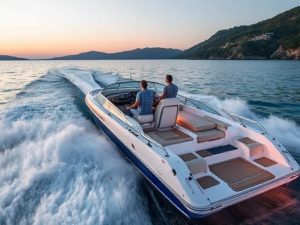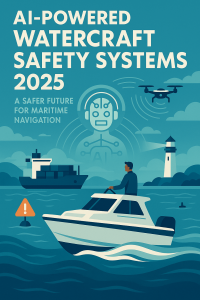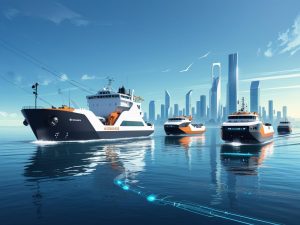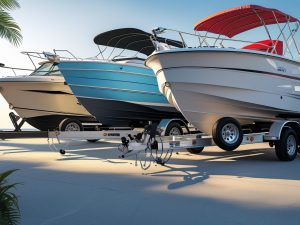In 2025, the boating industry continues to evolve with a sharp focus on sustainability, fuel economy, and environmental responsibility. Whether you’re a weekend angler, a long-distance cruiser, or simply love spending time on the water, choosing a fuel-efficient boat can significantly reduce your operating costs and carbon footprint.
In this detailed guide, we’ll explore the most fuel-efficient boats in 2025, breaking down their key features, efficiency ratings, and what makes them stand out. We’ll also answer some frequently asked questions to help you make an informed choice.
1. Introduction
Fuel efficiency isn’t just a land-based concern anymore—marine fuel prices have soared in 2025, and eco-conscious consumers are demanding greener alternatives. Manufacturers are responding with innovations in hull design, hybrid propulsion systems, and lightweight materials.
If you’re planning to invest in a boat this year, going fuel-efficient is the smart, future-forward move.
2. What Makes a Boat Fuel-Efficient?
Understanding what impacts a boat’s fuel economy is essential. Here are the primary factors:
-
Hull Design: Displacement and semi-displacement hulls offer better mileage.
-
Engine Technology: Newer 4-stroke outboards, hybrid systems, and electric motors are more efficient.
-
Weight and Load: Lighter boats burn less fuel.
-
Speed and RPM: Optimal cruising speed enhances efficiency.
-
Propeller Selection: The right prop maximizes thrust and minimizes drag.
Now let’s review the top-performing boats in terms of fuel efficiency in 2025.
3. Top 10 Most Fuel-Efficient Boats in 2025
1. Beneteau Swift Trawler 35
-
Fuel Burn: 1.7 mpg at 8 knots
-
Engine: 425 HP Cummins
-
Range: 440 NM
The Swift Trawler 35 is a staple for long-distance cruisers who value fuel economy. With a semi-displacement hull and smart energy use, this boat is both luxurious and economical.
2. Ranger Tugs R-27
-
Fuel Burn: 3.2 mpg at 20 knots
-
Engine: 300 HP Yamaha
-
Range: 280 NM
Compact yet capable, the R-27 is a trailerable trawler that sips fuel. Ideal for solo cruisers or couples, it combines performance with surprisingly low fuel consumption.
3. Axopar 28 Cabin
-
Fuel Burn: 3.5 mpg at 30 knots
-
Engine: 300 HP Mercury V8
-
Range: 350 NM
With Scandinavian engineering and a sleek design, the Axopar 28 is a crowd-favorite. It glides effortlessly over the water, making it one of the most efficient fast boats available.
4. Greenline 40 Hybrid
-
Fuel Burn: Near-zero on electric / 2.8 mpg on diesel
-
Engine: Hybrid (Diesel + Electric)
-
Range: 700 NM combined
This hybrid beauty is setting new standards. The Greenline 40 can operate silently on electric power at low speeds, drastically cutting down fuel usage and emissions.
5. MJM 35z
-
Fuel Burn: 2.5 mpg at 35 knots
-
Engine: Twin 300 HP Mercury Verado
-
Range: 300 NM
One of the few performance-oriented express cruisers offering solid mpg at high speeds. The MJM 35z is a marvel of lightweight design and advanced propulsion.
6. Jeanneau NC 1095
-
Fuel Burn: 1.6 mpg at 25 knots
-
Engine: Twin 300 HP Yamaha
-
Range: 250 NM
Perfect for family cruising, the NC 1095 offers three cabins, comfortable amenities, and fuel economy that’s impressive for its size.
7. Pursuit S 268
-
Fuel Burn: 3.1 mpg at 28 knots
-
Engine: Twin Yamaha F150
-
Range: 240 NM
This fishing machine is as economical as it is rugged. Anglers appreciate its durability and smart fuel burn rate, even at higher speeds.
8. Aspen C100 Escape
-
Fuel Burn: 4.0 mpg at 18 knots
-
Engine: 200 HP Suzuki
-
Range: 360 NM
Thanks to its asymmetrical catamaran hull, the Aspen C100 Escape offers unrivaled efficiency and stability. A rare find in the cruising segment.
9. Boston Whaler 325 Conquest
-
Fuel Burn: 1.8 mpg at 30 knots
-
Engine: Twin Mercury 300 HP
-
Range: 270 NM
Built for offshore adventures, this model brings together seaworthiness and respectable fuel economy—rare for boats in its class.
10. Yamaha 190 FSH Sport
-
Fuel Burn: 5.2 mpg at 25 knots
-
Engine: Single 1.8L Yamaha HO Jet
-
Range: 150 NM
Jet boats are not typically fuel-efficient, but the 190 FSH Sport is an exception. It’s compact, powerful, and ideal for nearshore fishing trips with minimal fuel cost.
4. Electric and Hybrid Boats Leading in Efficiency
The future is electric—and the boating world is catching up. Here are a few top performers in this new class of ultra-efficient vessels:
Silent 60
-
Solar-powered catamaran
-
Infinite range under sunny conditions
-
Zero emissions, virtually no fuel cost
Candela C-8
-
Fully electric hydrofoil boat
-
2.5 hours runtime at 20 knots
-
Ultra-efficient and whisper-quiet
X Shore Eelex 8000
-
100% electric
-
Up to 100 NM range
-
Fast charging in under 2 hours
Electric boats may have shorter ranges than their fuel-powered counterparts, but their zero-emission output and ultra-low operational cost are turning heads in 2025.
5. Tips to Maximize Boat Fuel Efficiency
Even the most efficient boats need smart handling. Here’s how to stretch every gallon:
-
Trim Your Boat Properly: Reduces drag.
-
Maintain the Engine: Clean filters and spark plugs = better burn.
-
Use the Right Propeller: Match pitch and diameter to your cruising style.
-
Don’t Overload: Keep gear and passengers within weight limits.
-
Plan Efficient Routes: Avoid strong currents and unnecessary stops.
6. Environmental Impact of Fuel-Efficient Boats
Choosing a fuel-efficient boat doesn’t just save money—it’s a step toward sustainable marine recreation.
-
Lower Emissions: Less CO₂ and hydrocarbons released.
-
Reduced Noise Pollution: Electric/hybrid systems are quiet.
-
Less Fuel Spillage Risk: Modern fuel systems are safer.
-
Marine Conservation: Smaller carbon footprint = better ocean health.
7. Conclusion
The demand for fuel-efficient boats in 2025 is shaping the future of marine technology. Whether you’re into fishing, cruising, or day boating, there’s an economical and eco-friendly vessel to suit your needs.
From hybrid trawlers to fully electric hydrofoils, manufacturers are stepping up to meet the challenge of sustainability. Investing in a fuel-efficient boat not only supports the environment but also ensures lower long-term ownership costs.
8. Frequently Asked Questions (FAQs)
Q1: What is considered good fuel efficiency for a boat in 2025?
Most efficient boats in 2025 offer 2.5 to 4 mpg at cruising speeds. Electric boats, while not measured in mpg, are considered the most efficient overall.
Q2: Are electric boats practical for long-distance cruising?
Currently, electric boats are ideal for short to mid-range trips. Hybrid boats are better suited for long-distance due to backup diesel capabilities.
Q3: What type of hull design is best for fuel efficiency?
Semi-displacement and catamaran hulls typically offer superior fuel economy, especially at moderate cruising speeds.
Q4: Are fuel-efficient boats more expensive?
Initially, yes—due to advanced tech and design. However, the long-term fuel and maintenance savings often outweigh the upfront cost.
Q5: How can I track my boat’s fuel efficiency?
Install a fuel flow meter or use integrated marine electronics that monitor gallons per hour (GPH) and miles per gallon (MPG) in real-time.
Q6: Can I retrofit my current boat to improve fuel efficiency?
Yes. Consider upgrading to a more efficient propeller, re-powering with a modern engine, or even adding solar panels for electric support.
Q7: Do hybrid boats qualify for tax incentives?
In some regions and states, yes—green or hybrid marine vehicles may qualify for eco-incentives or rebates.
Q8: Are fuel-efficient boats slower?
Not necessarily. Many 2025 models, like the Axopar 28 Cabin, achieve both high speeds and fuel economy through innovative design.
Q9: Where can I buy fuel-efficient boats in 2025?
Look to authorized dealerships, boat shows, and certified resellers. Online platforms like Boat Trader and YachtWorld also list eco-friendly options.
Q10: Is solar power a viable energy source for boats?
Absolutely. Modern solar-powered boats like the Silent 60 offer significant range under the right weather conditions, with zero emissions.





